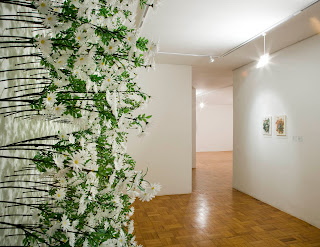José Roca, the Artistic Director for Philagrafika is going to begin a series of posts from his curatorial travel to South America and Asia. This travel was funded by a grant by the Warhol Foundation.
Dear friends of Philagrafika:
In Brazil I installed a small show in which I had been working for more than two years, and that was finally realized this past month. There is more information on the website(http://www.nararoesler.com.br/exposicoes/otras-floras)


It is a reconsideration of the scientific traveler, and the relationships between botanics and politics, and includes older artists such as Arnulf Rainer, Mark Dion, Roxy Paine, Jan Fabre and Maria Fernanda Cardoso. There are also younger artists like Jaime Tarazona and Miler Lagos, whom we have invited to participate in Philagrafika 2010. Miler created an 8-foot tall tree made of stacked newspapers, which he then carves to create the sculpture. I am enclosing some photos of the installation.
The Pinacoteca do Estado de Sao Paulo, has a beautiful show of Maria Bonomi, a highly respected artist here in Brazil who has worked in xylography (spanish for woodcut) since the sixties. I also visited Regina Silveira's exhibition at Brito Cimino, and later her studio (http://www.britocimino.com.br/en-exposicoes-presente.html). The show looks amazing, and has everything to do with our ideas for the festival in Philadelphia in 2010. I am also enclosing photos. The current show is about the biblical plagues; some of them are all types of bugs, that were gleaned from old engravings and illustrations and either blown up and rendered in plotter-cut vinyl, or screen-printed on decals that were then applied to white china (for the table service visible on one of the images).
For those of you that might not be so familiar with her work, since the seventies, Regina has been working in alternative forms of printing, using toner in lithographic stones, distributing flyers, applying screen-printed decals on various three-dimensional surfaces, and eventually taking this work to the public sphere by intervening façades of buildings. I did a survey show of her work last year at my (ex) museum in Bogotá.
The opening of the Bienal de Sao Paulo was a success. As the curators Ivo Mesquita and Ana Paula Cohen (whom I invited last year to co-curate the Encuentro de Medellín) chose to discuss the ideas associated with the void, the space looks, well, empty.
Prior to curating this show, I first saw this space completely empty when I met with my fellow co-curators in 2005. Yet, it’s breathtaking to see this immense building with hardly any works of art installed as part of a curated statement.
Here’s a link to the curatorial statement:
http://bienalsaopaulo.globo.com/english/fundacao/noticias/noticias_evento.asp?IDNoticia=154
There are works, of course, but most of them are almost imperceptible, since they either reflect on emptiness of the space or on the idea of the archive. One of Ivo’s ideas was to use this biennial as a think-tank to reconsider Biennials and “Biennalism”, so there is a large archive with catalogs of all the past and current biennials, triennials, quadriennials, etc, and many artists working on personal or public archives.
There is a very beautiful work by Dora Longo Bahía. She has been an artist concerned with counter-culture in Brazilian poorer neighborhoods, especially the alternative rock scene in Brazil.
She has done several works where she sets up a radio station in the gallery.She is also a painter, and calls her large-scale paintings “scalps”, as they seem something that has been pulled off with force and scarred, a bloodied trophy of sorts.
For the Bienal she covered the whole floor of the third level (more than 12.000 square feet) in screen-printed self-adhesive tiles, which will be walked upon by visitors, slowly revealing the red paint underneath and in doing so, mapping the various patterns and intensities of the circulation of the visitors of the exhibition.
Another project that interested me was Erick Beltrán’s “The World Explained”, an encyclopedia that is done in real time with the definitions provided by the public. I worked with Erick in San Juan and Medellín, and each time he pushes his ongoing project of mapping the way thought functions, a little further. For the Bienal he set up a sort of edition house in real time, with tables where people write their definitions, his assistants transcribe them, a designer does the mise-en-page, and the page is immediately printed on an offset press. By the end of the Bienal we will have a 200-page encyclopedia. On the third floor of the Bienal there is a structure that tries to represent visually and spatially the processes of thought.
At the Pinacoteca I saw Spanish artist Cristina Iglesias’ show. It was a series of large-scale installations; models of site-specific projects and public art commissions; and some interesting printed works related to the installations. There was a labyrinthine installation done with tresses made with braided wire, and a very beautiful suite of prints based on photographs of this installation. The technique was described to me as this: she takes photographs of the installations, which she prints digitally on a metal plate and etches, then reworks directly on the plate with drypoint.
There were also two large-scale screen prints on copper plates done from images of the models for her installations.
More to come.
Jose.
Saturday, November 08, 2008
Post from José Roca: Philagrafika trip to Brazil
Subscribe to:
Post Comments (Atom)

















No comments:
Post a Comment